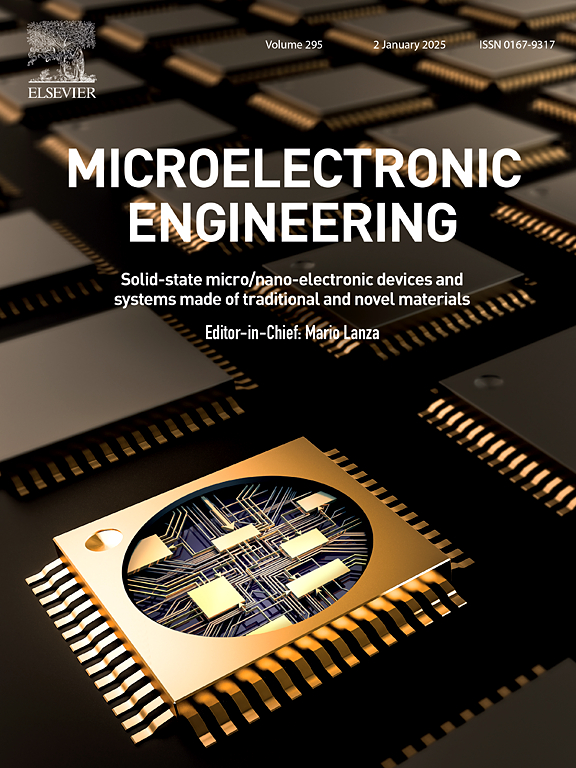基于非光敏聚酰亚胺的高电感三维拱形电感器
IF 3.1
4区 工程技术
Q2 ENGINEERING, ELECTRICAL & ELECTRONIC
引用次数: 0
摘要
三维 MEMS 电感器具有寄生电容低、基片损耗小和电感值高等优点,因此越来越多地应用于微电子领域,如 MEMS 传感器、射频 MEMS 和储能设备。传统的制造技术,包括 UV-LIGA 光刻技术和硅通孔 (TSV) 技术,通常用于制造高宽比结构的三维电感器。然而,这些工艺往往复杂且具有挑战性。为了简化工艺,我们提出了一种利用非光敏聚酰亚胺制造弧形电感器的新方法。聚酰亚胺的高粘度有利于在显影过程中形成倾斜的侧壁,从而无需在电感器制造过程中采用高宽比结构。通过控制显影时间,我们可以获得所需的聚酰亚胺侧壁形态。此外,为了实现高电感,我们还使用了一种高渗透性 Co 基非晶合金丝作为电感器的磁芯。在 71.4 MHz 的激励频率下,电感器的最大电感可达 1710 nH。本文章由计算机程序翻译,如有差异,请以英文原文为准。

High inductance 3D arch inductor based on non-photosensitive polyimide
Due to their low parasitic capacitance, minimal substrate losses, and high inductance values, three-dimensional MEMS inductors are increasingly used in microelectronics applications, such as MEMS sensors, RF MEMS, and energy storage devices. Conventional fabrication techniques, including UV-LIGA lithography and through‑silicon vias (TSV), are commonly employed to create high-aspect-ratio structures for 3D inductors. However, these processes are often complex and challenging. To simplify the process, we proposed a novel fabrication method for arched inductors utilizing non-photosensitive polyimide. The high viscosity of polyimide facilitates the formation of sloped sidewalls during development, eliminating the need for high-aspect-ratio structures in the inductor fabrication. By controlling the development time, we achieve the desired polyimide sidewall morphology. Additionally, to achieve high inductance, a high-permeability Co-based amorphous alloy wire was used as the magnetic core of the inductor. The maximum inductance of the inductor can reach 1710 nH at an excitation frequency of 71.4 MHz.
求助全文
通过发布文献求助,成功后即可免费获取论文全文。
去求助
来源期刊

Microelectronic Engineering
工程技术-工程:电子与电气
CiteScore
5.30
自引率
4.30%
发文量
131
审稿时长
29 days
期刊介绍:
Microelectronic Engineering is the premier nanoprocessing, and nanotechnology journal focusing on fabrication of electronic, photonic, bioelectronic, electromechanic and fluidic devices and systems, and their applications in the broad areas of electronics, photonics, energy, life sciences, and environment. It covers also the expanding interdisciplinary field of "more than Moore" and "beyond Moore" integrated nanoelectronics / photonics and micro-/nano-/bio-systems. Through its unique mixture of peer-reviewed articles, reviews, accelerated publications, short and Technical notes, and the latest research news on key developments, Microelectronic Engineering provides comprehensive coverage of this exciting, interdisciplinary and dynamic new field for researchers in academia and professionals in industry.
 求助内容:
求助内容: 应助结果提醒方式:
应助结果提醒方式:


